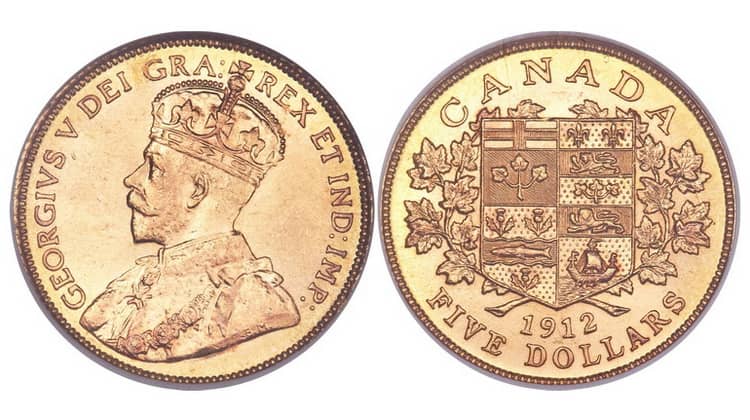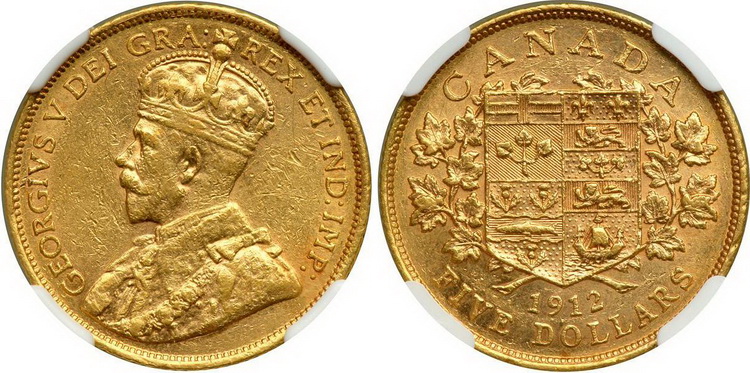
5 Canadian dollars (1912-1913) is the first gold coin of regular issue, introduced into circulation during the reign of George V. The coinage of these coins, as well as similar copies of 10 dollars denomination, was suspended as soon as Canada officially entered the war. The next step of the country’s government was the withdrawal of all 5 and 10 dollar gold coins from circulation for melting down and financing military operations. This is how the majority of previously issued circulation perished. All 10 Dollars Canadian gold coins in our catalog. However, immediately after the end of the war, the Ministry of Finance of the country announced that the coins of these denominations would soon be reissued. The reissue did not take place, and in 1928 the Canadian government completely abandoned the coinage of the gold coins of the regular issue.
Special features of Canadian coins design
Five Canadian dollars, like all other coins of regular issue, are issued under the auspices of the royal mint, whose main office is situated in Ottawa, and the main production facilities in Winnipeg. Since the country has a bilingual system, coins are mainly produced in two versions – with inscriptions in French and English. However, it can be difficult to tell which coin you hold in your hands, because the designers always try to match words that are identical in both languages. Moreover, gold and silver commemorative coins of Canada of special series are distinguished by their reverse. Almost always there are inscriptions that sound the same in both French and English. The obverse of collectible coins, such as the gold coins of the Maple Leaf series is distinguished by the fact that it usually contains inscriptions (title and name of the ruling monarch) in Latin, most often abbreviated.
The modern commemorative and collectible coins, such as silver coins of the Maple Leaf series, are no different from their predecessors, except for the name of the ruler. On their obverse, there is an inscription “ELIZABETH II D. G. REGINA”. The abbreviation “D. G. ” stands for “Dei Gratia”, the entire phrase can be translated as “Elizabeth II, Queen by the grace of God”. The inscription “Dei Gratia” is typical for almost all Canadian coins. The only series issued without this note was dedicated to the Winter Olympic Games in Vancouver 2010. On copies of the coins of that series “CANADA ELIZABETH II” is engraved instead of the usual inscription “ELIZABETH II D. G. REGINA”.
Specifications of 5 Canadian dollar coin
All 5 Dollars Canadian gold coins in our catalog.
Among amateur collectors, there is an opinion that coins with a denomination of 5 Canadian dollars were issued only in 1912 and 1913, as the First World War prevented the launch of a regular issue in 1914. This is not entirely true. The Canadian authorities still managed to issue a relatively small circulation of coins of this denomination, but most of the coins produced in 1914 were withdrawn from circulation and melted into gold bars. Today the gold coin of 5 dollars of the 1914 issue is one of the most significant numismatic rarities.
Years of issue: 1912-1914
Metal: gold
Diameter: 21.6 mm
Weight: 8.359 g
Thickness: 1.82 mm
Edge: reeded
Types of coinage: regular issue.
Designers: William Henry James Blakemore (reverse), Edgar Bertram MacKennal (obverse).
Circulation: 165,680 (1912); 98,832 (1913), 31,122 (1914).
The obverse of the coin shows a profile image of the reigning King George V. Above it there is an inscription “George V, King by the grace of God”. On the reverse of the coin there is a shield, where the coat of arms of the Dominion of Canada is depicted. The inscription “Canada” is above the coat of arms and denomination and year of issue is under it.

History of Canadian coins
Since 1858, various colonies of British North America have started to issue their coins, called cents, with the image of the Queen Victoria on the obverse. They replaced the sterling that was in circulation before. The province of Canada was the first one to issue coins worth more than 10 cents. This was an urgent decision, since coins of a smaller denomination, especially 1 cent, were extremely unpopular because of very low weight. Other colonies that issued coins with denominations more than 10 cents were New Brunswick and Nova Scotia, which, together with Canada, were merged into one dominion by a decree of the British Parliament in 1867. The coins of all three former colonies were legal tender in all provinces and continued to circulate in the dominion until 1870. A few years later, all former colonies entered the confederation and immediately refused to mint their own coins in favor of the national Canadian currency.
In 1870, the first coins of the Dominion of Canada were issued. Their denominations were 5 ¢, 10 ¢, 25 ¢ and 50 ¢. A coin of 1 cent denomination was not issued until 1876, because of the low cost on the market. The design of coins was standard: an image of Queen Victoria on the obverse, and denomination, date of coinage and national symbol – maple leaf on the reverse. All 1865-1947 Province Canadian gold coins in our catalog.
In 1902, the first coins of the period of reign of King Edward VII were issued. The 1902 coin of 5 cents denomination is interesting to collectors, since its design includes the obsolete crown of St. Edward instead of the Imperial State Crown. These coins immediately spread to private collections, as the public felt that the designers had made a mistake. In 1903, the design of a 5 cents coin was changed to the usual one.
In 1908, the Mint was opened in Ottawa. At that time, the Ottawa Mint was known as the Royal Mint, the Ottawa branch. The name “Royal Mint of Canada” was first used in 1931. Three years after the opening, the Mint initiated experiments on gold processing with electrolysis. This method was too expensive and time consuming, so in 1915, the mint adopted the innovative chlorination process, which was developed in Australia. This method significantly shortened the processing time and increased the amount of pure gold. All Canadian pure gold coins in our catalog. Ever since, the mint facilities have undergone a number of extensions and improvements. The current process of gold processing at mint facilities is a successful combination of electrolysis and chlorination.
Cost of coins
The copies of 1914 are considered to be the rarest gold coins of 5 dollar denomination. They are sold and bought at a price of 700-800 US dollars, depending on the place of the auction. The coins of 1912 and 1913 are valued a little lower; they can be bought at a price of 260 dollars.
Interesting facts
- The gold coins of regular issue of ten and five dollar denomination were produced in Canada only from 1912 to 1914, because the coinage of precious metals was previously prohibited by decree of the British Parliament. It was believed that an independent issue of the Canadian gold dollar would violate the “royal prerogative” of Britain.
- According to the data of the Canadian Mint, the vast majority of the circulation of gold coins of the 1912-1914 issue was kept in the Bank of Canada for about 75 years. Only in 2012, the mint released 30,000 coins from this impressive collection for sale. It was also stated that the remaining 245,000 pieces would be melted down and then sold at world auctions.
Comments
No commens yet.